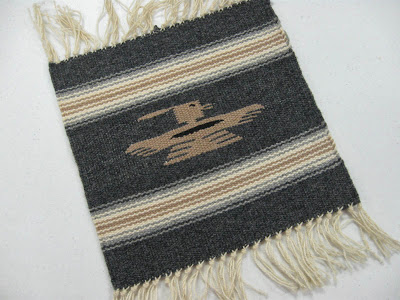The
Riverbend Fiber Arts Guild had an informative program on
Navajo weaving at the October guild meeting. Mary Wells, who was inspired to learn weaving through her exposure to Navajo woven textiles, shared her personal experience from a two-week healthcare tour of a Navajo community in the southwest.
 |
| Navajo weaving on an upright loom. |
Navajo weaving is a tapestry weaving technique that uses a vertical loom and produces fixed-width textiles. The textiles are very finely woven with coarse, but sturdy yarn. Twined selvedges [multiple heavier warp yarns that are twisted together] are incorporated for strength and durability.
 |
| Mary at her vertical Navajo-style loom. |
"The Navajo tribes were originally nomadic and followed the grazing paths of the
Churro sheep," said Mary as she talked about the history of the Navajo people. The wool from these long-haired animals was spun into the yarn for weaving. The colors used to dye the yarn came from local plants, minerals and insects, so a community's handiwork could often be identified by the color palettes of the textiles. Uncommon yarn colors found in some weavings were likely obtained from traders and missionaries. "The appearance of these colors can be a source for dating the textiles," Mary added. The patterns and design motifs that were woven into the textiles were also unique to each Navajo community.
Mary described the Navajo culture as reverent, respectful and environmentally conscious. "Their life philosophy is that every object has a spirit path," she explained. "So, a hole or a disruption in the pattern was woven into their textiles to provide a path for the spirit to enter and exit."
 |
| The details of this motif illustrate the finely woven Navajo style. |
The most common items produced were blankets, saddle blankets, cloaks and, after trading commenced, rugs.
 |
| Small Navajo weaving [approximately 12 " square]. |
The highly-twisted, coarse wool is strong, durable and conducive to these items.
 |
| Single ply over-spun yarn used for traditional Navajo weaving. |
Using a cotton yarn, Judy Anderson gave a demonstration on warping a half-size Navajo loom. This is a continuous warp process for this weft-faced textile. Shed sticks, battens, beaters and forks are other tools used in the weaving process.
 |
| Judy (right) demonstrates warping the loom. |
Books can be found on the history, culture and traditions of the Navajo people and their weaving style. Some out-of-print books and resources on Navajo weaving, constructing a loom, tools and the weaving process are still available at your local library, through guilds, used book stores and on-line.
Resources recommended by the program presenters include:
Navajo Weaving Way, Navajo and Hopi Weaving Techniques, Working With the Wool, The Magic of Spider Woman, The Woven Spirit of the Southwest, The Weaver's Pathway, and
The Book of the Navajo.
 |
Resources and reference books on the Navajo weaving process, tools
and constructing a loom. |
Children's books, such as
The Spinner's Gift,
Abuela's Weave, and
Sunflower's Promise, provide insight into the culture, traditions and myths through stories that both young and young-at-heart will find fascinating and enjoyable.
 |
| Children's books and stories that illustrate Navajo culture and customs. |































